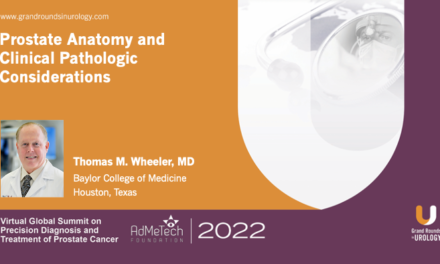Laurence Klotz, MD, FRCSC, presented “MRI-guided Transurethral Ultrasound Ablation (TULSA) for Prostate Cancer” during the 25th Annual Southwest Prostate Cancer Symposium conference on December 11, 2021, in Scottsdale, Arizona.
How to cite: Klotz, Laurence. “MRI-guided Transurethral Ultrasound Ablation (TULSA) for Prostate Cancer.” December 11, 2021. Accessed Jul 2024. https://grandroundsinurology.com/mri-guided-transurethral-ultrasound-ablation-tulsa-for-prostate-cancer/
MRI-guided Transurethral Ultrasound Ablation (TULSA) for Prostate Cancer – Summary
Laurence Klotz, MD, Professor of Surgery at the University of Toronto and the Sunnybrook Chair of Prostate Cancer Research, discusses the technology, procedure, outcomes, and regulatory environment surrounding MRI-guided transurethral ultrasound ablation (TULSA) treatment for patients with prostate cancer. He begins by displaying a chart of multiple minimally invasive treatment options for prostate cancer. Dr. Klotz lists prospective studies of focal therapy that found relatively few adverse quality-of-life (QOL) effects. He goes on to compare five ultrasound-based technologies in terms of biopsy and prostate-specific antigen (PSA) outcome, concluding that data demonstrates these therapies work. Dr. Klotz emphasizes that there is not currently a way to differentiate the oncological efficacy of these treatments, citing the number of variables and reiterating that they all are reasonably effective. Dr. Klotz then turns the discussion to MRI-guided transurethral ultrasound ablation (TULSA), explaining the function of the technology and the system components involved, explaining that the energy delivered is controlled by a closed-loop control system. He outlines the key features of the TULSA system, explaining that it delivers transurethral directional ultrasound ablation which is incision and radiation free, and there is no energy coming through the rectum and there is no volume limitation. Further, real-time MRI thermal dosimetry and ablation control means temperature is measured in real time and the system adjusts the amount of energy delivered to the tissue, providing precision, actively compensating for tissue and blood flow changes during the treatment. Finally, the system offers thermal protection of important anatomy (i.e., urethra and rectum cooling). Dr. Klotz then outlines the evolution of the TULSA technology, including technical studies, canine studies, first-in-man treatment, and feasibility studies. He describes the TULSA-PRO Ablation Clinical Trial (TACT), which involved 115 patients across 13 institutions in five countries, with safety (frequency/severity of adverse events) and efficacy (PSA reduction ≥75 percent in >50 percent of patients) being the primary endpoints at 12 months. Ninety-six percent of patients had a PSA reduction ≥75 percent at 12 months and at the 12-month MRI the median prostate volume had decreased from 41 to 4 cc (a decrease of 90 percent). Further, the treatment preserved continence and erectile function. In a three-year follow-up among men who underwent the treatment, just 11 percent needed salvage treatment. Dr. Klotz explains the challenges involved in demonstrating level-one evidence for the benefit of new technologies since benefits tend to be incremental and gradual. He cites the da Vinci robot as an important example and explains that the U.S. Food and Drug Administration (FDA) has acknowledged this in its approval of high intensity focused ultrasound (HIFU) and TULSA (for tissue ablation). Dr. Klotz concludes with a summary of the TULSA technology, procedure, outcomes, and regulatory considerations, explaining that this new technology is being offered in the US and Europe and is pending in Canada.
About the 25th Annual Southwest Prostate Cancer Symposium:
Presented by Program Chairs Nelson N. Stone, MD, and Richard G. Stock, MD, this conference educated attendees about advances in the management of localized and advanced prostate cancer, with a focus on imaging, technology, and training in the related devices. It included a scientific session, as well as live demonstrations of surgical techniques. You can learn more about the conference here.
ABOUT THE AUTHOR
Laurence Klotz, MD, FRCSC, is a professor of surgery at the University of Toronto and the Sunnybrook Chair of Prostate Cancer Research. Dr. Klotz was the founding editor-in-chief of both the Canadian Journal of Urology and the Canadian Urology Association Journal (CUAJ), and he is now editor emeritus of the CUAJ. Dr. Klotz obtained his medical degree and completed his residency at the University of Toronto. He was also a uro-oncology fellow at Memorial Sloan Kettering Cancer Center in New York.
Dr. Klotz has 550 peer review publications and eight books. He coined the phrase “active surveillance” and successfully championed this approach for men with favorable-risk prostate cancer against substantial resistance. He was the associate editor of the Journal of Urology, responsible for prostate cancer, for eight years. Dr. Klotz received the Queen’s Jubilee Medal for outstanding public service, the University of Toronto's Lister Prize, the Society of Urologic Oncology’s SUO Medal, the American Urological Association’s Richard Williams Award, the University of Toronto's Lifetime Achievement Award, the Canadian Urological Association Lifetime Achievement Award, and the Harold Warwick Award from the Canadian Cancer Society for “outstanding contributions to cancer control.” In 2015 he was inducted as a Member of the Order of Canada, Canada’s highest civilian award.




